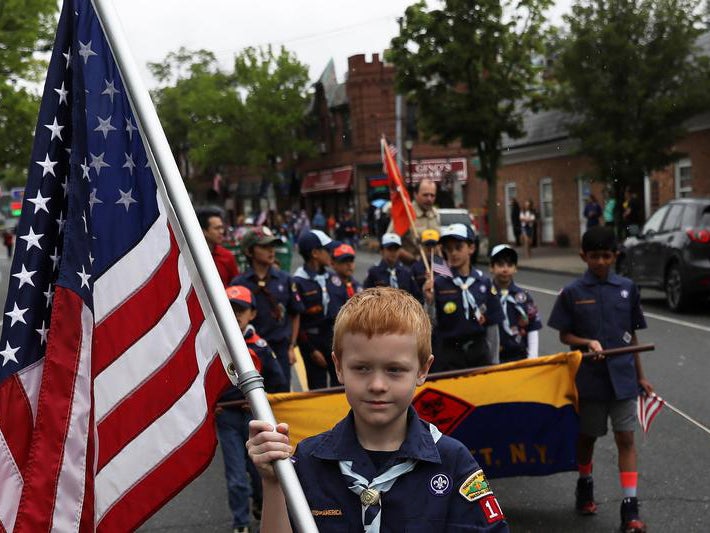Boy Scouts removing the word 'boy' from their name
'We're here for both young men and young women'

Your support helps us to tell the story
From reproductive rights to climate change to Big Tech, The Independent is on the ground when the story is developing. Whether it's investigating the financials of Elon Musk's pro-Trump PAC or producing our latest documentary, 'The A Word', which shines a light on the American women fighting for reproductive rights, we know how important it is to parse out the facts from the messaging.
At such a critical moment in US history, we need reporters on the ground. Your donation allows us to keep sending journalists to speak to both sides of the story.
The Independent is trusted by Americans across the entire political spectrum. And unlike many other quality news outlets, we choose not to lock Americans out of our reporting and analysis with paywalls. We believe quality journalism should be available to everyone, paid for by those who can afford it.
Your support makes all the difference.The Boy Scouts of America’s flagship programme is allowing girls to enter its ranks for the first time in more than a century — and it will change its name to match.
The new name for its Boy Scouts programme, which is run for 11 to 17-year-olds, will be Scouts BSA from next February.
“We wanted to land on something that evokes the past but also conveys the inclusive nature of the program going forward,” said Chief Scout Executive Mike Surbaugh, adding that many possibilities were considered during deliberations over the name.
Her added: "We’re trying to find the right way to say we’re here for both young men and young women.”
Despite the programme’s name change, the parent organisation will remain the Boy Scouts of America, and the Cub Scouts, the programme for 7- to 10-year-olds – will also keep its title.
The organisation has already started admitting girls into the Cub Scouts, and Scouts BSA begins accepting girls next year.
Mr Surbaugh predicted that both boys and girls in Scouts BSA would refer to themselves simply as scouts.
The program for the older boys and girls will largely be divided along gender-lines, with single-sex groups pursuing the same types of activities, earning the same array of merit badges and potentially having the same pathway to the coveted Eagle Scout award.
Mr Surbaugh said dividing the groups should alleviate concerns that girls joining the BSA for the first time might be at a disadvantage in seeking leadership opportunities.
So far, more than 3,000 girls have joined roughly 170 Cub Scout packs participating in the first phase of the new policy, and the pace is expected to intensify this summer under a nationwide multimedia recruitment campaign titled “Scout Me In.”
The name change comes amid strained relations between the Girl Scouts and Boy Scouts of America.
Girl Scout leaders said they were blindsided by the move and they are gearing up an aggressive campaign to recruit and retain girls as members.
Among the initiatives is creation of numerous new badges that girls can earn, focusing on outdoor activities and on science, engineering, technology and math. The organisation is expanding corporate partnerships in both those areas, and developing a Girl Scout Network Page on LinkedIn to support career advancement for former Girl Scouts.
“Girl Scouts is the premier leadership development organisation for girls,” said Sylvia Acevedo, the Girl Scouts’ CEO. “We are, and will remain, the first choice for girls and parents who want to provide their girls opportunities to build new skills ... and grow into happy, successful, civically engaged adults.”
The Girl Scouts and the BSA are among several major youth organisations in the US experiencing sharp drops in membership in recent years. Reasons include competition from sports leagues, a perception by some families that they are old-fashioned and busy family schedules.
The Boy Scouts say current youth participation is about 2.3 million, down from 2.6 million in 2013 and more than 4 million when the group was at its most popular.
The Girl Scouts say they have about 1.76 million girls and more than 780,000 adult members, down from just over 2 million youth members and about 800,000 adult members in 2014.
The overall impact of the BSA’s policy change on Girl Scouts membership won’t be known any time soon. But one regional leader, Fiona Cummings of Girl Scouts of Northern Illinois, believes the BSA’s decision to admit girls is among the factors that have shrunk her council’s youth membership by more than 500 girls so far this year.
She said relations with the Boy Scouts in her region used to be collaborative and now are “very chilly".
“How do you manage these strategic tensions?” she asked. “We both need to increase our membership numbers.”
Mr Surbaugh said BSA’s national leadership respected the Girl Scouts’ program and hoped both organisations could gain strength.
“If the best fit for your girl is the Girl Scouts, that’s fantastic,” he said. “If it’s not them, it might be us.”
Associated Press contributed to this report
Join our commenting forum
Join thought-provoking conversations, follow other Independent readers and see their replies
Comments